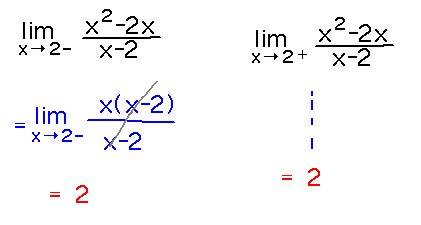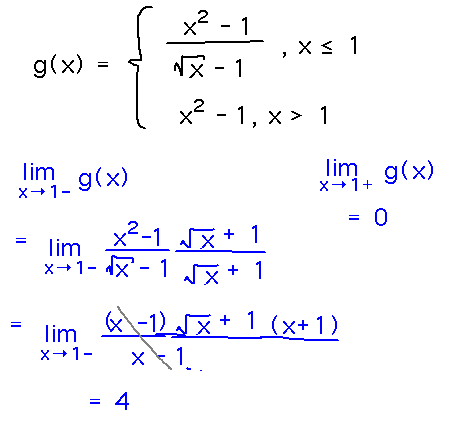Questions?
One-Sided Limits
“One-Sided Limits” subsection of section 2.2
Examples
Problem. Find limx→2- (x2 - 2x) / (x-2) and limx→2+ (x2 - 2x) / (x-2).
Reading ideas: Limits from left or right are indicated by - or + in limit subscript.

Take-Aways.Limit laws, algebra, etc. work for 1-sided limits as well as 2-sided. 1-sided limits can sometimes be the same as 2-sided (standard) limits.
Problem. Find limx→0- (2√x + 1) and limx→0+ (2√x + 1).
limx→0- (2√x + 1) does not exist because it deals with negative values of x and √x isn’t a real number when x is negative. But limx→0+ (2√x + 1) = 1 by plugging in x = 0.
Take-Away.1-sided limits let you talk about limits that don’t exist from both sides, but watch out for the temptation to work on the side where the function values don’t exist.
Problem. Define f(x) by the rules f(x) = x + 1 if x < 0, f(x) = x2 + 1 if x ≥ 0. Does limx→0 f(x) exist? If so, what is it?

Problem. Define g(x) by the rules g(x) = (x2 - 1) / (√x - 1) if x ≤ 1 and g(x) = x2 - 1 if x > 1. Show that limx→1 g(x) does not exist.
Strategy: Find limx→1+ g(x) and limx→1- g(x), and show that they are unequal.

Take-Aways.if left limit = right limit, then both equal the 2-sided limit. Otherwise the 2-sided limit does not exist. One-sided limits are helpful if not essential for dealing with piecewise functions.
Next
Infinite limits
Read the “Infinite Limits” subsection of section 2.2.